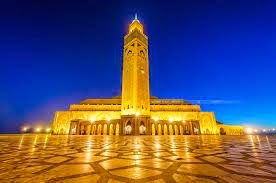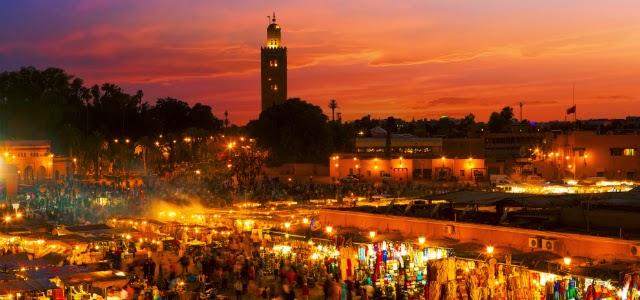
Casablanca , My beautiful city
- Casablanca is Morocco's
largest city and the country's main port which translates into quite a
few gritty and industrial-looking neighborhoods. But Casablanca is also
the most cosmopolitan of Morocco's cities, with nightclubs, fast food
chains and high end boutiques. Below you'll find facts and information
about Casablanca, where to stay, eat and what to see.
Casablanca is often the first stop for international passengers
flying in from afar, and the city is basically used as a transit point.
But before you dismiss it entirely and quickly move on to Fes, Rabat or Marrakech, you must stop to visit the Hassan II Mosque, honestly one of the most beautiful buildings ever built.It is also the largest city in the Maghreb, as well as one of the largest and most important cities in Africa, both economically and demographically.
What to See and Do in Casablanca
- The Corniche - Sometimes referred to as the "South Beach of Morocco", or the "Blackpool of Morocco", the Corniche is basically a boardwalk lined with restaurants and nightclubs. It's where local folks go to relax and have fun. Take a stroll down the Corniche if you've spent time inland and want to enjoy the sea breeze. It's a little out of the center of town, so you'll need a cab. If it's hot, nip into one of the swimming pools owned by beach clubs and hotels along here
- Best time to Visit Casablanca
Casablanca is blessed with a mild climate, the winters are not too cold, but can be rainy. Summers are hot, but the cooling breeze from the Atlantic makes it more bearable than say Marrakech or Fes.
- Getting to Casablanca
By Air -- most people arrive in Casablanca at the Mohammed V international airport. It's a 45 minute taxi ride into the center of town, or you can catch a commuter train if you are on a budget (terminal 1). There are direct flights from the US (Royal Air Moroc), South Africa, Australia and the Middle East . Flights are plentiful from every major European capital. Regional flights from Dakar are also frequent and you'll discover that Casablanca is quite a hub for West African passengers going to and from the Americas.
By Train - Casablanca Voyageurs is the main train station in town, where you can catch a train to Fes, Marrakech, Rabat, Meknes, Asilah and Tangier. See my guide to Morocco Train Travel for details.
By Boat - Cruise ships dock at the port in Casablanca and often allow for a two night sojourn into Morocco. Most people will hop on a train to Marrakech or Fes, so just grab a taxi to the train station in the center of town, Casa Voyageurs (see above).
By Bus CTM long distance buses stop in several parts of the city, so make sure you know where your hotel is to get off at the right stop. Casablanca is the transport hub of Morocco, you can take a bus to anywhere in the country from here, most long-distance routes will depart early in the morning.
- Where to Stay in Casablanca
Unlike Marrakech, Fes or Essaouira, there are not a lot nice boutique hotels, or a tastefully decorated Riads in Casablanca. The upscale Hotel Le Doge does offer a great experience and a wonderful spa. For a less expensive more intimate experience, check out Dar Itrit.
If you're only spending a night in Casablanca, my personal choice is Hotel Maamoura. It's a very friendly, 3 star, Moroccan run hotel where a double room will set you back around USD 60. The hotel offers a simple breakfast, they organize early taxis to the airport and it's close to the main train station which is convenient if you're traveling to and from Marrakech or Fez. The Hotel les Saisons also offers a similar experience at a reasonable price.
For bland but predictable luxury, check out the Le Royal Mansour Meridien or the Hyatt Regency.
Neighborhoods:
- 2 Mars
- Ain Sebaa
- Belvédère
- Bouchentouf
- Bourgogne
- Californie
- Centre Ville (downtown)
- C.I.L.
- Derb Gallef
- Derb Sultan Al Fida
- Derb TAZI
- El Hank
- El Hay El Mohammadi
- Gauthier
- Habous
- Hay Dakhla ("Derb Lihoudi")
- Hay Farah
- Hay El Hana
- Hay Moulay Rachid
- La Colline
- Laimoun (Hay Hassani)
- Lissasfa
- Maârif
- Old Madina (Mdina Qdima)
- Mers Sultan
- Nassim
- Oasis
- Oulfa
- Polo
- Racine
- Riviera
- Roches Noires
- Salmia II
- Sbaata
- Sidi Bernoussi
- Sidi Maarouf
- Sidi Moumen
- Sidi Othman
In popular culture ! :
- Casablanca is the setting of the 1942 film of the same name starring Humphrey Bogart and Ingrid Bergman. The film has achieved worldwide popularity since then. Nominated in eight categories, it won three Oscars.
- A Night in Casablanca (1946) was the twelfth Marx Brothers' movie. The film stars Groucho Marx, Chico Marx, and Harpo Marx. It was directed by Archie Mayo and written by Joseph Fields and Roland Kibbee. The film contains the song "Who's Sorry Now?", with music by Ted Snyder and lyrics by Bert Kalmar and Harry Ruby. It is sung in French by Lisette Verea playing the part of Beatrice Rheiner, and then later sung in English. Liszt's "Hungarian Rhapsody No. 2" is played twice, once by Chico on piano as an intro to the "Beer Barrel Polka", and again by Harpo on the harp.
- The city is featured in The Mysterious Caravan (1975), Volume 54 in the original Hardy Boys series.
- Casablanca is the setting for several chapters in Doubleshot, a 2000 James Bond novel by Raymond Benson. In the novel, one of the characters mentions that the 1942 film was shot in Hollywood and not on location.
- Casablanca is one of the key locations in the 2006 video game Dreamfall, as it is where the primary protagonist of the game, Zoë Castillo, lives. Although the city is imagined in the year 2219, much of the present day architecture is used for inspiration.
.png)











